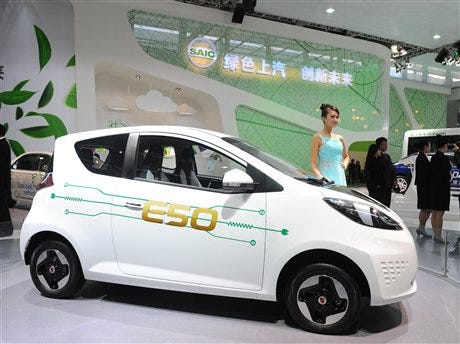Chinese electric car employs extensive plastics for lightweighting
The Chinese-built Roewe E50 electric vehicle was in the spotlight at the recent Shanghai International Industry Fair 2011 on Shanghai Motor's booth, underscoring the benefits of lightweight design solutions from Evonik Industries (Essen, Germany).
February 22, 2012
The Chinese-built Roewe E50 electric vehicle was in the spotlight at the recent Shanghai International Industry Fair 2011 on Shanghai Motor's booth, underscoring the benefits of lightweight design solutions from Evonik Industries (Essen, Germany).
|
Polymethacrylimide, epoxy and acrylic resins deliver lightweighting solutions in electric vehicle. |
The lithium ion battery-powered E50 uses several lightweight materials from Evonik for various applications to support reduced energy consumption and lower emissions, such as Plexiglas acrylic resin for the side screens, rear window and rear lamp, and Rohacell polymethacrylimide (PMI) rigid closed cell foam and an epoxy resin formulation based on Vestamin hardener technology for the engine hood.
"We are proud to have played a part in providing Shanghai Motor's first electric car with our lightweight and environmentally progressive plastic solutions," said Xu Hang, Evonik's Project Head of Lightweight Design in China.
The use of a coated acrylic to replace traditional mineral glass in the Roewe E50 demo car reduces weight of the fixed side screens by up to 40-50% according to Evonik. It also helps to reduce energy consumption and CO2 emission. The advantages of Plexiglas glazing include UV stability and good acoustic properties. In addition, the car designer can achieve more design freedom with this material and gain sophisticated curve structure, which is not feasible when using traditional glass. The special grade of Plexiglas material is also employed in the rear lamps of the Roewe E50 to achieve a special light diffusing effect.
The engine hood of the Roewe E50 uses Rohacell PMI structural foam as the core material in a sandwich structure. Compared to a steel engine hood, the sandwich version saves up to 70% in weight. Due to outstanding heat resistance and mechanical strength of the Rohacell material, it can reportedly shorten curing cycles at elevated temperatures above 130°C and offer a cost efficient production. Further, because of its high mechanical strength at low densities, even small thicknesses of Rohacell enable the construction of light weight body parts with ultra-high stiffness.
With the aim to support high output production of composite body parts, a new epoxy resin formulation based on Vestamin hardener technology was used in the resin infusion manufacturing process. Short cycle times can thereby be realized that are suitable for mass production.-[email protected]
About the Author(s)
You May Also Like



